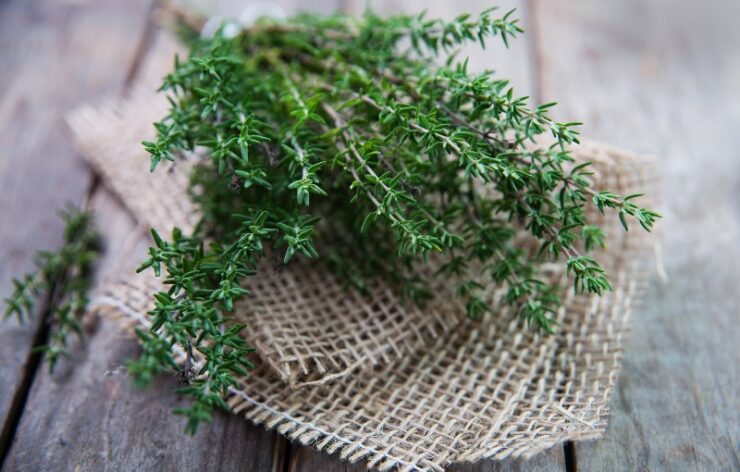Thyme pops up in countless recipes, from cooking to baking to cocktails. Its signature woodsy, menthol-like flavor is a staple across almost all cuisines.
From culinary school, to professional kitchens, and at home, I’ve come across many excellent thyme substitutes. So if you find yourself in the middle of a recipe without a sprig of thyme in sight, don’t worry, I’ve got simple replacements for all applications.
Together, we will go over when to choose an alternative and how to incorporate it into your recipe. Save time by using one of these 8 thyme substitutes in your recipe.
In This Article
Simple Swaps For Thyme & How To Use Each One
Oregano
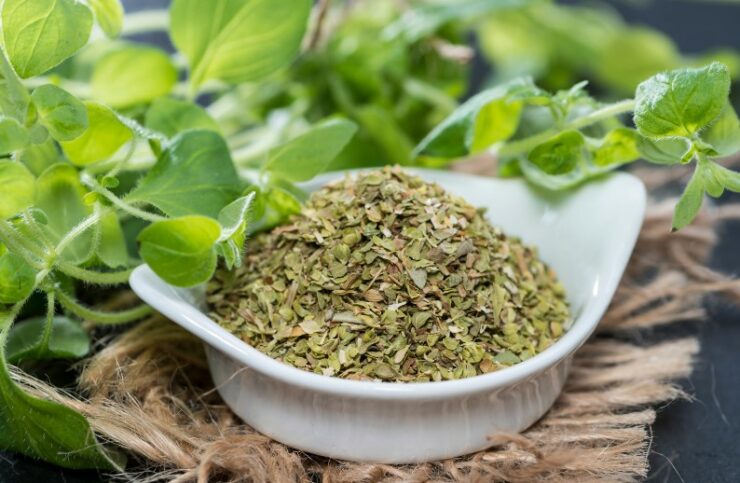
Oregano is probably the herb closest in flavor to thyme, especially when swapping one fresh herb for the other. Universally, you can use oregano instead of thyme across all of your recipes.
Cooked meats, veggies, sauces, soups, stews, and stocks are all perfect candidates to use oregano as an alternative to thyme.
Oregano is bold and earthy, whereas thyme is sweet, peppery, and minty. Still, both have distinct lemony, woodsy notes at the forefront of their flavor.
When swapping thyme for oregano in a dish, it’s a bit more punchy but, you’ll hardly notice a difference.
Marjoram
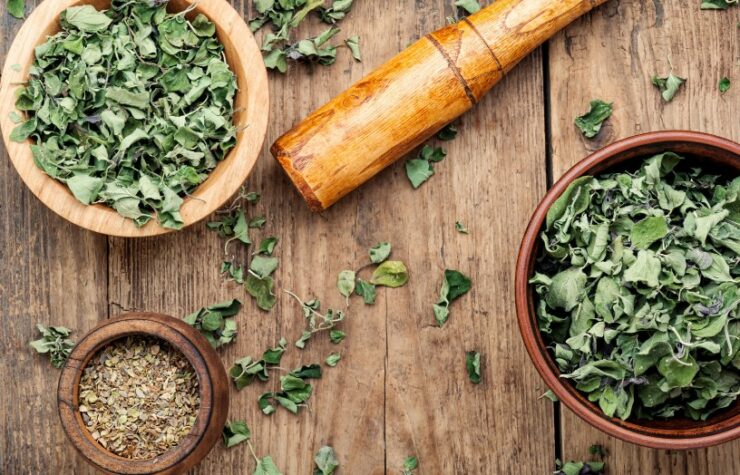
The taste of marjoram is almost identical to oregano, so just as oregano is a perfect alternative to thyme, so is marjoram.
Incorporate marjoram into your stocks, broths, soups, and stews to deepen their flavor. Add marjoram to any sauces that call for thyme, whether they be cream sauces or gravies. You can even garnish a cocktail with a sprig of marjoram in a pinch.
Marjoram is a simple swap for all recipes that call for thyme, whether cooked or cold, incorporated or garnished. Substitute equal parts marjoram for thyme in any of your recipes.
Parsley

Parsley is an excellent substitute for thyme, especially in cold dishes. It has less of an earthy, woody taste that’s typical of thyme and has more of a bright bitter flavor.
Parsley compliments the flavor of salads or chilled creamy dips especially well.
Fresh parsley has more bitter notes than the dried alternative. Something to consider when choosing which option will suit your taste preferences.
Egg salads, potato salads, chicken, or pasta salads that call for thyme will be just as delicious with parsley in its place.
Substitute thyme for parsley at a 1:1 ratio.
Rosemary
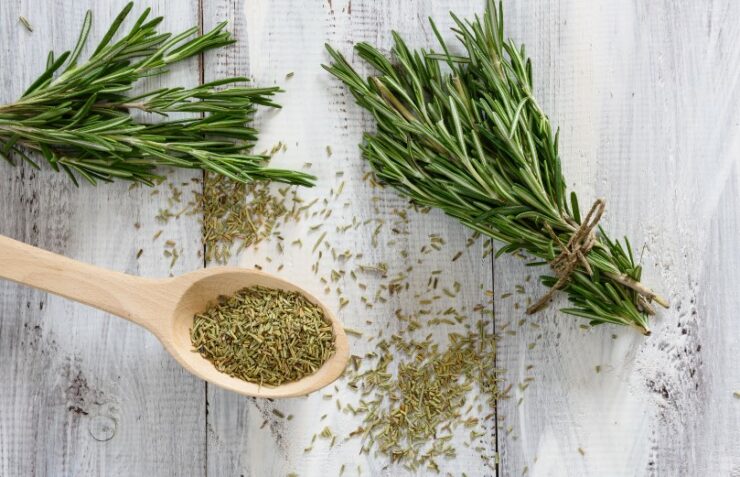
Rosemary is the best option when you’re looking for a thyme alternative for roasted or braised pork, beef, or potatoes. But also feel free to use it for poultry dishes, broth-based soups, stews, and cocktails.
Rosemary is extraordinarily woodsy and aromatic, much like thyme. Its flavor leads with an evergreen note that mellows into a citrusy, slightly menthol-like taste that perfectly compliments hearty meats and potatoes.
Alternatively, use it to garnish cocktails or flavor broths.
This is another simple swap since you can use rosemary as an alternative for thyme at a 1:1 ratio. However, if you’re using this herb directly in a dish, be sure to chop it finely, as large pieces can overpower your palate.

Pro-Tip: I find that rosemary overpowers the flavor of tomato. So if you’re looking for a thyme alternative for tomato sauce, soup, or the like, opt for oregano or marjoram instead.
Basil
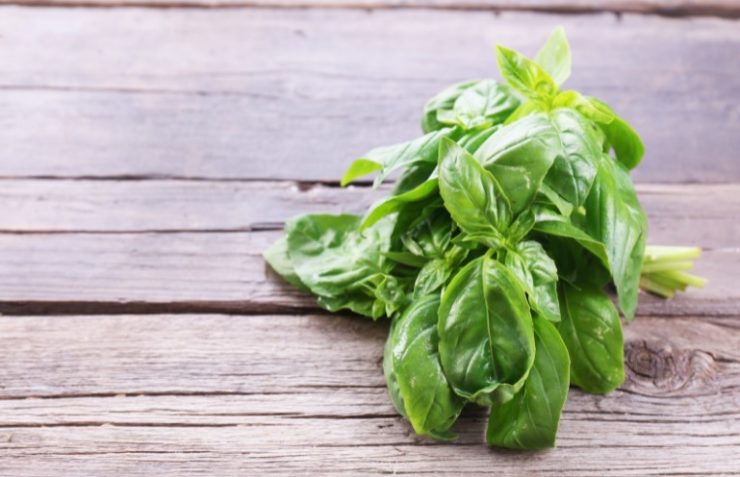
You’ll often find thyme garnishing cocktails with bourbon, berries, grapefruit, or another bright citrus. You might even come across a thyme simple syrup in some drink recipes. But, if you haven’t tried basil in its place, you’re missing out.
Fresh basil’s licorice and clove-like flavor is a perfect substitute for any cocktail application.
You can even experiment with other varieties of sweet basil in your cocktails. Genovese basil and lemon basil are excellent alternatives for cocktails. But don’t be afraid to delve into a spicier option like a cinnamon variety or anise-heavy Thai basil.
This swap couldn’t be more simple; substitute basil for thyme at a 1:1 ratio.
Tarragon
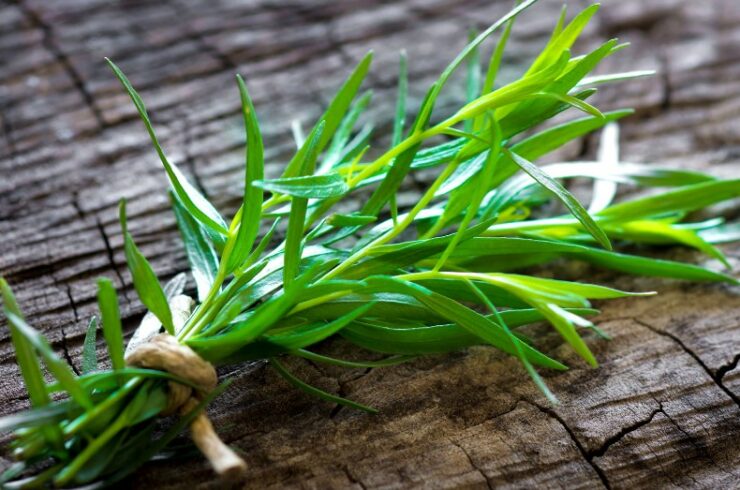
Tarragon has a similar mild flavor to thyme but with a bit more bitterness in its finish. Its flavor is reminiscent of licorice, anise, or fennel and elevates any dish with its aromatics. It’s a delicious alternative for thyme in all cases, but especially on fish or poultry.
I prefer using dried tarragon instead of fresh in place of dried or fresh thyme. Fresh tarragon leaves a unique taste distinct from thyme. However, the dried version of the herb is much more passable.
Substitute equal parts tarragon for thyme in any of your recipes.
Bay Leaf

You can swap out thyme for bay leaf if you’re whipping up a slow-cooked soup or stew, like a classic French Onion Soup recipe.
Bay leaf has both a floral and herbal taste. When simmered into hearty dishes, the menthol-like bitterness in bay leaf lifts and enriches the taste of the broth. Similar to thyme, you’ll end up with a spiced, woodsy, delicious depth of flavor throughout the dish.
It’s easy to go overboard with bay leaves if you add too much. An entire stockpot of liquid only needs 1-2 bay leaves. So, when swapping out thyme, you won’t need precise measurements for this alternative. Stick to adding 1 bay leaf for 4 servings and 2 leaves for 6.
If you’ve never used bay leaf before, be sure to keep the leaves whole so they are easy to fish out and discard once you’re done cooking. In most cases, the leaves themselves are too tough and overpowering to eat, but they add wonderful flavor and aroma to whatever they are cooked with.
Herbes de Provence
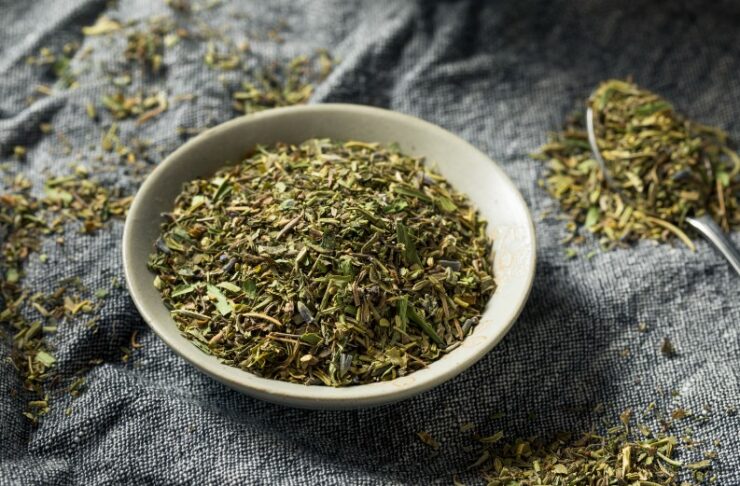
Herbes de Provence is a seasoning blend often used in French cuisine. It’s common enough in standard grocery stores that you might already have some in your cabinet.
The main herbs in this blend are thyme, oregano, marjoram, rosemary, basil, tarragon, and bay leaf. All of which are included in this substitution list.
This universal alternative to thyme works in any application when thyme leaves are chopped and added directly to your recipe.
If your recipe calls for dried thyme, you can swap these at a 1:1 ratio. If your recipe calls for fresh thyme, use about half the amount of dry Herbes de Provence.

Pro-Tip: If you don’t have Herbes de Provence on hand but have some Italian Seasoning in the cabinet, you can use that too. They have similar herbs in different proportions, but both will have a hefty amount of thyme.
Tips For Working With Thyme Alternatives
You can use both dried and fresh herbs in place of thyme, but keep in mind the difference in potency. Dried herbs have a stronger taste than fresh ones, so you’ll need to adjust the ratio accordingly by scaling down.
When swapping fresh herbs for dried, halve the necessary portion. On the other hand, when substituting dried herbs for fresh, double the required amount.
Frequently Asked Questions
Can I use parsley in place of thyme?
Parsley is an excellent substitute for thyme, especially in cold dishes. It has less of an earthy, woody taste that’s typical of thyme and has more of a bright bitter flavor. Parsley compliments the flavor of salads or chilled creamy dips.
What can I use instead of thyme in french onion soup?
Use bay leaf, oregano, marjoram, or Herbes de Provence, in place of thyme in your french onion soup. Any of these herbs impart a rich depth of flavor to the broth, especially when simmered over an extended period.
How do I substitute dried thyme for fresh?
To substitute dried thyme in place of fresh, halve the amount necessary for the recipe. To substitute fresh thyme for dried, double the required amount.
